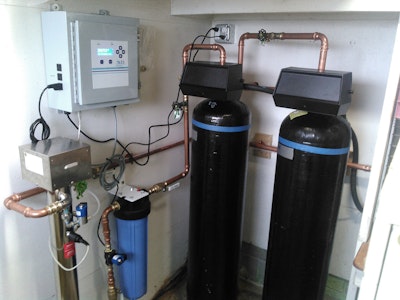
Under proposed EPA rules, treatment of drinking water would be required after the testing of water systems reveals one or more MCL exceedances.
Interested in Education/Training?
Get Education/Training articles, news and videos right in your inbox! Sign up now.
Education/Training + Get AlertsPerfluoroalkyl and polyfluoroalkyl substances (PFAS) are a family of chemical compounds that have been manufactured and used around the world since the 1940s. The most common chemicals used in the PFAS group — perfluorooctanoic acid (PFOA) and perfluorooctane sulfonate (PFOS) — are known as “forever chemicals” because they are very persistent in the environment.
PFAS have been widely used in nonstick cookware, cleaning products, firefighting foams, and the textile and packaging industries. Due to their widespread use and persistence in the environment, most Americans have detectable levels of PFAS in their blood. Scientific and medical studies demonstrate that long-term exposure to high levels of certain classes of PFAS can cause significant human health effects, including alteration of immunological responses, liver damage, and decreased birth weight, and may cause kidney and testicular cancer.
The EPA’s roadmap
Over the past decade, some state governments have established maximum contaminant levels and corrective actions for potable water sources impacted by PFAS; however, a federal regulatory framework has not existed. In 2021, the United States Environmental Protection Agency developed and published a nationwide approach to research, regulate and remediate PFAS.
The EPA’s document, “PFAS Strategic Roadmap: EPA’s Commitments to Action 2021-2024,” contains a comprehensive, multiyear program with three key stages:
- Research: Develop a research program to better understand the human health effects of certain groups of PFAS and how these chemicals move through and persist in the environment.
- Regulate: Develop a comprehensive approach to proactively prevent PFAS from entering water, land and air at levels that cause human health and ecological damage. Develop nationwide monitoring and regulatory programs for drinking water and effluent limits for industry, publicly owned pretreatment works and landfills.
- Remediate: Develop and measure the effectiveness of PFAS mitigation technologies and develop new methods, standards, and programs to treat PFAS in water, soil and air.
Proposed MCLs
On March 14, 2023, the EPA took a major step toward regulating and remediating PFAS by issuing proposed nationwide maximum contaminant levels for PFOA and PFOS at 4 parts per trillion. The EPA also proposed using an established hazardous index calculation as the MCL for any mixture containing one or more of the following chemicals: hexafluoropropylene oxide dimer acid (GenX Chemicals), perfluorobutane sulfonic acid and its potassium salt, perfluorononanoic acid, and perfluorohexane sulfonic acid. Treatment of drinking water would be required after the testing of water systems reveals one or more MCL exceedances.
The EPA has stated that public comments will be considered in the promulgation of the final MCLs, with the final rule being issued by the end of 2023. With the proposed federal framework for PFAS in place, it is anticipated that when the nationwide MCLs are issued as final, states that have previously established their own MCLs will likely adopt the EPA’s federal MCLs to retain primacy of their respective state drinking water programs.
When to Start Testing
The decision of when to start sampling and analyzing a public water system for PFAS has always been a tough call for municipal managers. Now that the EPA has issued proposed nationwide MCLs for PFAS that are projected to be finalized by the end of 2023, the decision of when to assess your water system and source has become clear — the time has arrived. Consultants, engineers and treatment plant operators generally agree that it is more advantageous to test for PFAS and design/build treatment systems before the flood of nationwide regulation-enforced supply chain issues drive costs up.
Funding Assistance
There is funding available now to pay for infrastructure upgrades that address PFAS and communities that apply for funding first will have a much better chance of receiving financial assistance. The Bipartisan Infrastructure Law provided the EPA with more than $50 billion to distribute to states, tribes and territories — primarily via the State Revolving Fund program — for water and sewer infrastructure improvements. The EPA implements the SRF program through state agencies that provide funding to municipalities through grant and loan programs. Bipartisan Infrastructure Law funding may also be provided to states for distribution outside of the SRF program.
A significant share of the $50 billion has been set aside to address emerging contaminants, including PFAS.
- $5 billion is available for drinking water upgrades, which may include addressing emerging contaminants such as PFAS, in small or disadvantaged communities. States can apply for this funding to provide grants to disadvantaged communities of less than 10,000 in population that are underserved (i.e., have no drinking water or have a water system that violates federal drinking water requirements).
- Another $4 billion is available for drinking water improvements through the Drinking Water State Revolving Fund. All funding will be provided as grants or principal forgiveness loans.
- States and communities can also leverage an additional nearly $12 billion in revolving funds dedicated to making drinking water safer.
To avail your community of these funding sources, need and readiness to conduct the improvement must be proven with an approvable preliminary engineering evaluation.
Preparing your community
The reality is that many community water supplies will exceed these new federal MCLs for PFAS contamination. Community leaders need to take action and prepare for the likely outcome of MCL exceedance.
- Prepare for Community Reaction: Any announcement about the safety of public water will understandably garner intense media attention and community concern. It is critical that the announcement be accompanied by a plan of action for minimizing exposure and treating the contamination. For this reason, it is imperative to engage a professional to assist with developing a communications plan prior to testing, as testing results are often subject to disclosure pursuant to applicable state and federal freedom of information laws.
- Solicit State and Federal Funding: The federal government and state agencies are putting funding sources in place to help communities pay for PFAS testing and treatment. These funding streams are limited, so smart communities will take advantage of these programs and apply as early as possible.
- Engineering Evaluation and Treatment Options: Partner with an experienced and trusted consultant to help analyze treatment options and design a viable solution for your community.
Community leaders that take steps to prepare and plan for the testing results will be most successful in addressing citizens’ concerns and mitigating potential mistrust and will be well-positioned to receive the necessary funding for their project. Careful planning and preparation now could make all the difference in leading your community through the PFAS issue for years to come.
Greg Senecal is a certified hazardous materials manager and environmental director at LaBella Associates.







